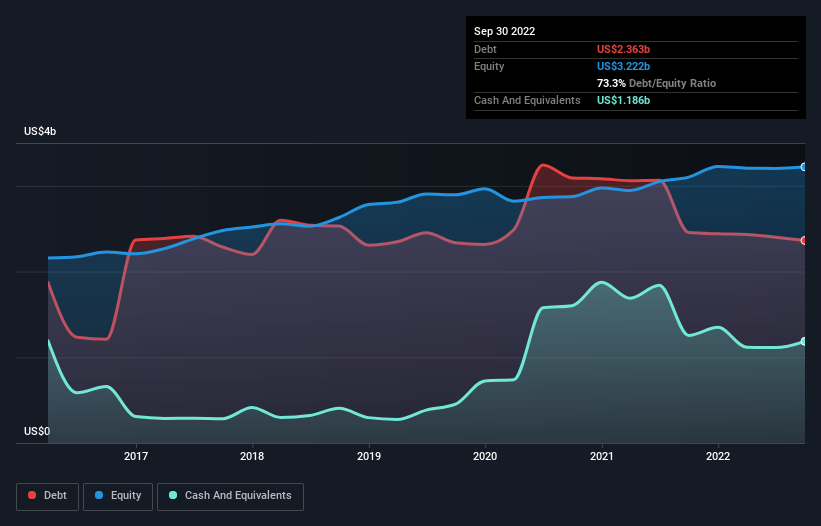
Some say volatility, rather than debt, is the best way to think about risk as an investor, but Warren Buffett famously said that ‘Volatility is far from synonymous with risk.’ It’s only natural to consider a company’s balance sheet when you examine how risky it is, since debt is often involved when a business collapses. We can see that Xylem Inc. (NYSE:XYL) does use debt in its business. But the more important question is: how much risk is that debt creating?
When Is Debt Dangerous?
Debt and other liabilities become risky for a business when it cannot easily fulfill those obligations, either with free cash flow or by raising capital at an attractive price. Part and parcel of capitalism is the process of ‘creative destruction’ where failed businesses are mercilessly liquidated by their bankers. However, a more frequent (but still costly) occurrence is where a company must issue shares at bargain-basement prices, permanently diluting shareholders, just to shore up its balance sheet. By replacing dilution, though, debt can be an extremely good tool for businesses that need capital to invest in growth at high rates of return. The first thing to do when considering how much debt a business uses is to look at its cash and debt together.
View our latest analysis for Xylem
What Is Xylem’s Net Debt?
As you can see below, Xylem had US$2.36b of debt, at September 2022, which is about the same as the year before. You can click the chart for greater detail. However, it does have US$1.19b in cash offsetting this, leading to net debt of about US$1.18b.

A Look At Xylem’s Liabilities
We can see from the most recent balance sheet that Xylem had liabilities of US$1.93b falling due within a year, and liabilities of US$2.96b due beyond that. Offsetting this, it had US$1.19b in cash and US$1.02b in receivables that were due within 12 months. So it has liabilities totalling US$2.68b more than its cash and near-term receivables, combined.
Since publicly traded Xylem shares are worth a very impressive total of US$21.1b, it seems unlikely that this level of liabilities would be a major threat. But there are sufficient liabilities that we would certainly recommend shareholders continue to monitor the balance sheet, going forward.
In order to size up a company’s debt relative to its earnings, we calculate its net debt divided by its earnings before interest, tax, depreciation, and amortization (EBITDA) and its earnings before interest and tax (EBIT) divided by its interest expense (its interest cover). Thus we consider debt relative to earnings both with and without depreciation and amortization expenses.
Xylem has a low net debt to EBITDA ratio of only 1.4. And its EBIT easily covers its interest expense, being 13.5 times the size. So we’re pretty relaxed about its super-conservative use of debt. But the other side of the story is that Xylem saw its EBIT decline by 7.8% over the last year. If earnings continue to decline at that rate the company may have increasing difficulty managing its debt load. There’s no doubt that we learn most about debt from the balance sheet. But it is future earnings, more than anything, that will determine Xylem’s ability to maintain a healthy balance sheet going forward. So if you’re focused on the future you can check out this free report showing analyst profit forecasts.
Finally, a business needs free cash flow to pay off debt; accounting profits just don’t cut it. So the logical step is to look at the proportion of that EBIT that is matched by actual free cash flow. Over the last three years, Xylem recorded free cash flow worth a fulsome 81% of its EBIT, which is stronger than we’d usually expect. That positions it well to pay down debt if desirable to do so.
Our View
Xylem’s interest cover suggests it can handle its debt as easily as Cristiano Ronaldo could score a goal against an under 14’s goalkeeper. But truth be told we feel its EBIT growth rate does undermine this impression a bit. Taking all this data into account, it seems to us that Xylem takes a pretty sensible approach to debt. That means they are taking on a bit more risk, in the hope of boosting shareholder returns. When analysing debt levels, the balance sheet is the obvious place to start. However, not all investment risk resides within the balance sheet – far from it. For example – Xylem has 2 warning signs we think you should be aware of.
If, after all that, you’re more interested in a fast growing company with a rock-solid balance sheet, then check out our list of net cash growth stocks without delay.
What are the risks and opportunities for Xylem?
Xylem Inc., together with its subsidiaries, engages in the design, manufacture, and servicing of engineered products and solutions for the water and wastewater applications in the United States, Europe, the Asia Pacific, and internationally.
Rewards
-
Earnings are forecast to grow 22.57% per year
Risks
-
Profit margins (6%) are lower than last year (8.8%)
-
Large one-off items impacting financial results
Have feedback on this article? Concerned about the content? Get in touch with us directly. Alternatively, email editorial-team (at) simplywallst.com.
This article by Simply Wall St is general in nature. We provide commentary based on historical data and analyst forecasts only using an unbiased methodology and our articles are not intended to be financial advice. It does not constitute a recommendation to buy or sell any stock, and does not take account of your objectives, or your financial situation. We aim to bring you long-term focused analysis driven by fundamental data. Note that our analysis may not factor in the latest price-sensitive company announcements or qualitative material. Simply Wall St has no position in any stocks mentioned.
Source link
